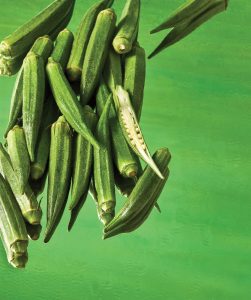
Photography by Bailey Garrot
High yield and hardy, okra thrives in the unrelenting heat of the South’s summer months. Thought to have been introduced to Louisiana from West Africa during the early 18th century by enslaved Africans, the plant’s resilience and diverse uses made it integral to the region’s foodways. You’ll see it fried, grilled, pickled, and stirred into gumbo as a thickening agent. Okra is itchy to pick and sticky to cook (blame a naturally occurring slime called mucilage), but those qualities are exactly what make it special—a singular and indispensable Southern culinary staple.
- While its exact etymology is disputed, most linguists believe that the word gumbo is derived from “ki ngombo,” a term meaning okra in several West African languages.
- Hard pressed for coffee because of Union blockades, Confederate soldiers turned to ground okra seeds as a substitute (albeit, a caffeine-free one). An 1863 newspaper article from Wilmington, North Carolina, hailed the brew as being “delicate and finely flavored, entirely wholesome” and “of a rich golden color.”
- The Irmo Okra Strut in South Carolina is the country’s oldest celebration of the crop, and 2025 marks its 50th anniversary. Stop by on September 26 and 27 for fried okra eating contests, carnival rides, multiple stages for musical performances, and the state’s largest parade.
- Gumbo Shop, set in a 1795 colonial townhouse in New Orleans’ French Quarter, has won the Best Gumbo category in the city’s reader poll every year since 1999. Try the okra-based seafood gumbo, made with the Creole “Holy Trinity,” shrimp, and crab.
- A perennial favorite of Charleston’s Post and Courier readers, Page’s Okra Grill in Mount Pleasant, South Carolina, does okra several ways: stewed with tomatoes, fried in cornmeal with a side of three-pepper ranch, and pickled as a garnish for its award-winning Bloody Marys.
This article appears in the Summer 2025 issue of Southbound.
Advertisement




